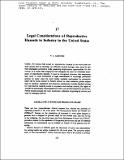Legal Considerations of Reproductive Hazards in Industry in the United States
Author(s)
Ashford, Nicholas A.
DownloadC. Legal Considn of Reproductive Hazards in US Industry CH 17 in Preg. Women at Work 1984.pdf (994.0Kb)
Terms of use
Metadata
Show full item recordAbstract
Clearly, the human risks posed by reproductive hazards in the work place are both serious and far-reaching. An effective control strategy, then, must be one that emphasises prevention while preserving employment opportunities for the worker. It is hoped that employers will recognise the need for voluntary abatement of reproductive hazards. It must be recognised, however, that employees may need to avail themselves of legal mechanisms to encourage preventive actions. In many cases the most readily available mechanisms for preventive relief will be those created by federal statute; in other instances, private actions may be required. Legislative and statutory mechanisms include standard-setting for reproductive hazards; access to exposure and medical records; the rights of workers to individually refuse hazardous work; and antidiscrimination protection. Private actions include the court injunction; collective bargaining by unions; and suits for damages suffered.
Date issued
1984Citation
Ashford N.A. (1984) Legal Considerations of Reproductive Hazards in Industry in the United States. In: Chamberlain G. (eds) Pregnant Women at Work. Palgrave, London. https://doi.org/10.1007/978-1-349-86031-9_17
Collections
The following license files are associated with this item: